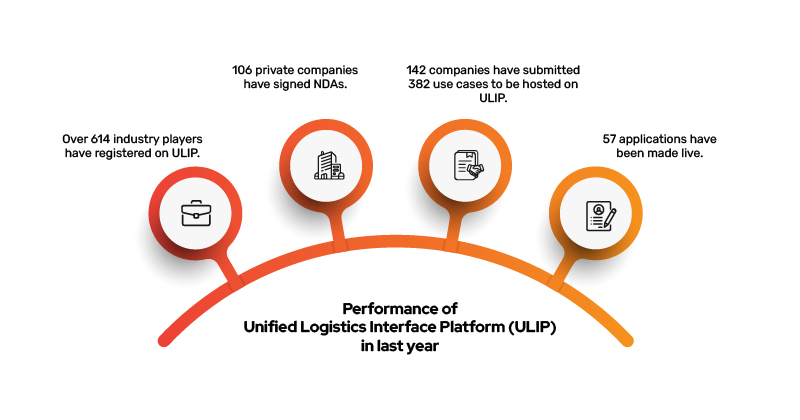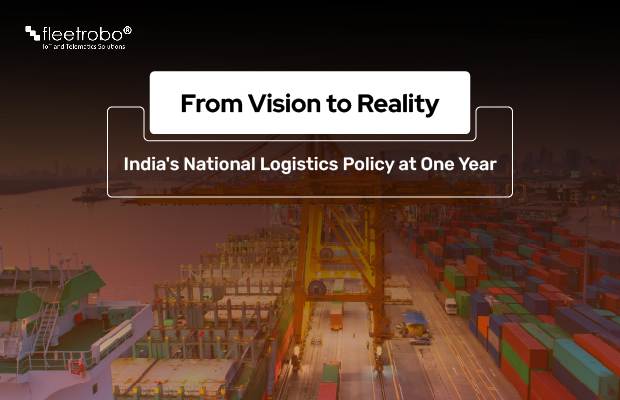News
On September 17, 2023, India commemorated the first anniversary of the National Logistics Policy. Substantial advancements have occurred in the implementation of the Policy since the introduction of the NLP. Let’s explore the notable enhancements brought in the last One year of NLP.
Unveiling India’s National Logistics Policy (NLP)
The National Logistics Policy (NLP) was officially introduced on September 17, 2022, To complement PM GatiShakti’s National Master Plan (NMP). The NLP focuses on various aspects of soft infrastructure and the development of the logistics sector. This includes but is not limited to process reforms, enhancements in logistics services, digitization, human resource development, and skill-building.
Vision
The vision of the NLP is to propel the economic growth and business competitiveness of the country. This will be achieved through the establishment of an integrated, seamless, efficient, reliable, green, sustainable, and cost-effective logistics network. This vision relies on harnessing best-in-class technology, processes, and skilled manpower.
Target
The targets of the NLP are to:
- Reduce cost of logistics in India;
- Enhance the ranking in the Logistics Performance Index with the aim of reaching the top 25 countries by 2030, and;
- Create data driven decision support mechanism for an efficient logistics ecosystem.
Comprehensive Logistics Action Plan (CLAP)
In pursuit of these objectives, the National Logistics Policy (NLP) has unveiled a Comprehensive Logistics Action Plan (CLAP). This plan encompasses eight key action areas such as Standardization of Physical Assets and Establishment of Service Quality Standards, Implementation of Integrated Digital Logistics Systems, Framework for Improving Logistics Services, etc.
Significant achievement of One year of NLP and CLAP
Unified Logistics Interface Platform (ULIP)
It is an indigenous data-based platform. It seamlessly integrates 34 digital systems and portals related to logistics across various Ministries and Departments. Notably, GST data is also being incorporated into the ULIP system.
Upon signing Non-Disclosure Agreements (NDAs) and undergoing due diligence, access to ULIP data is facilitated through API integration, allowing private entities to develop apps and use cases.

EXIM Logistics
The government has established an EXIM Logistics Group within the one year of NLP. The Logistics Data Bank (LDB) is an application designed for tracking and tracing EXIM cargo. By enhancing predictability, transparency, and reliability, it aims to reduce logistics costs and minimize wastages in the supply chain.
Human Resource Development
To support professionals in the sector, the government is issuing qualification packs for various job roles within the industry.
Sectoral Plan for Efficient Logistics (SPEL)
Within the one year of NLP, to cater to the unique requirements of the logistics sector and enhance the flow of bulk and break-bulk cargo within the country, user Ministries are formulating Sectoral Plans for Efficient Logistics (SPEL). These plans encompass sector-specific action plans and interventions essential for the smooth transportation of goods across various origin-destination pairs.
State Logistics Policy
To emphasize the importance of logistics in public policy at the state level, States and Union Territories (UTs) are in the process of formulating State Logistics Plans (SLPs) in alignment with the National Logistics Policy (NLP). Currently, within this One year of NLP, 22 States have officially notified their individual State Logistics policies.
Logistics Ease Across Different States (LEADS)
An indigenous logistics performance index, modeled after the World Bank’s LPI, known as the ‘Logistics Ease Across Different States (LEADS)’ index, has been formulated. This index serves the purpose of monitoring logistics performance across various states.
Note: The LEADS 2023 report is yet to be published.
Logistics Cost Framework
Currently, there is no official estimate available for the logistics sector’s contribution to the GDP. The existing estimates range from 8% to 14% of the GDP. For developing accurate estimates, the Logistics Division of DPIIT has initiated an endeavour.
Empowering Logistics Policy with FleetRobo

FleetRobo’s fleet management and logistics solutions optimize route planning, vehicle allocation, and driver scheduling. This enhances the overall efficiency and productivity of logistics operations, which aligns with the policy’s goal of reducing logistics costs. This can be done through,
Integrated Digital Logistics Systems
Ever since its inception, FleetRobo has been the pioneer of Integrated Digital Logistics Systems. For instance, FleetRobo’s Logistics Process Automation can digitize the Inbound and Outbound Logistics Management process, Automate Weighbridge, Parking and Security Checks, ensure seamless Integration with existing SAP solution and automate e-way billings. This will ensure an integrated and holistic solution for Logistics sector.
Standardization of Physical Assets
Standardization in the design and maintenance of vehicles and equipment promotes safety and reduces the risk of accidents during transportation and warehousing operations. For example, Implementing FleetRobo’s GPS E-Lock in logistics will not only standardize the locking mechanism used in the logistics, but also ensure safety and tracking facility. One can also customize alerts, reports and geo-fence your assets. The e-lock exhibits a 20% boost in operational efficiency compared to similar devices. To date, the e-lock has successfully thwarted over 15,000 incidents of pilferage and theft.
Improving Logistics Services
FleetRobo offers a range of services to improve the entire logistics sector. For instance, FleetRobo’s fuel monitoring system can generate advanced reports encompassing mileage monitoring, real-time tracking, and notifications for fuel theft or unexpected fluctuations in fuel levels. This capability empowers the logistics sector to ensure more precise planning and enhance fleet management.
FleetRobo’s Video Telematics solution is equipped with high-resolution cameras, advanced driver assistance systems (ADAS), and a driver status monitor (DSM). FleetRobo’s video telematics offers features such as driver behavior analysis, real-time traffic violation monitoring, and accident reconstruction support for insurance claims and police verifications, among others.
Intermodal Transportation
FleetRobo’s Consignment Tracking Solution can support the policy’s promotion of intermodal transportation by facilitating the efficient movement of goods across different modes, such as road and rail. This enables logistics sector to enhance their offerings, optimize their processes, and provide clients with a more reliable and efficient transportation experience.
Reducing Emissions
FleetRobo’s multiple solutions can help reduce the environmental impact of logistics operations by optimizing routes, reducing idling time, and improving fuel efficiency. This aligns with the policy’s goal of reducing emissions and promoting sustainability. Further, with solutions such as Figbytes, the logistics firm can comply with SEBI’s Business Responsibility and Sustainability Reporting (BRSR).
FleetRobo’s multiple solutions focused on making One year of NLP’s development into a long term reality. FleetRobo’s use of technology aligns with the policy’s goal of encouraging the adoption of technology and digital platforms in logistics operations. By leveraging FleetRobo solutions, the logistics industry can make significant strides toward achieving the objectives outlined in the National Logistics Policy.
To get more details please visit the FleetRobo’s website.

